According to Wikipedia :
Table of Contents
“Music is an art form whose medium is sound. Common elements of music are pitch (which governs melody and harmony), rhythm (and its associated concepts tempo, meter, and articulation), dynamics, and the sonic qualities of timbre and texture. The word derives from Greek ‘mousike'(art of the Muses)”
Music is therefore based on
- Pitch
- Rhythym
- Dynamics
- Timbre and texture
Notation must be able to indicate all the above
Rhythm
The first function of notation is to notate the rhythm. We do this by notating the length of notes that are played, and any that are not played ! (the rests). The following symbols indicate different note lengths, whch are related to the number of ‘beats’ that each not occupies.
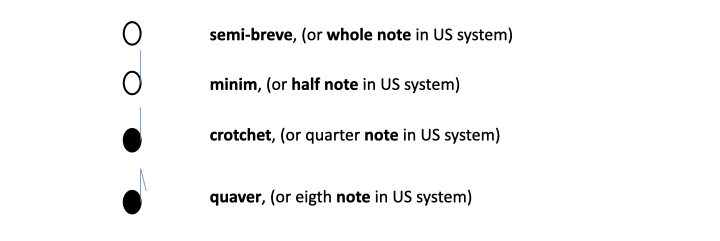
Blue Ridge Cabin Home
Let’s look at Blue Ridge Cabin Home, and notate the rhythm.
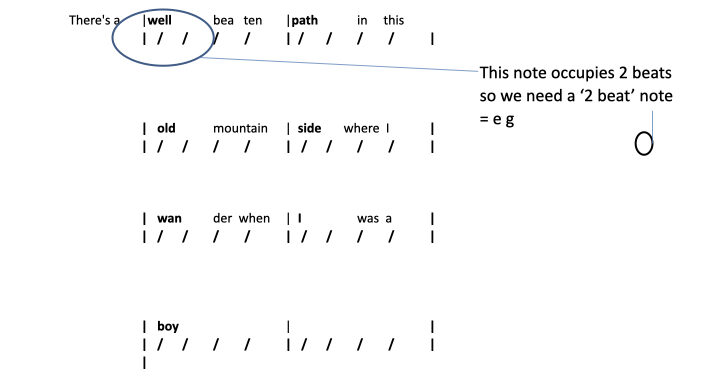
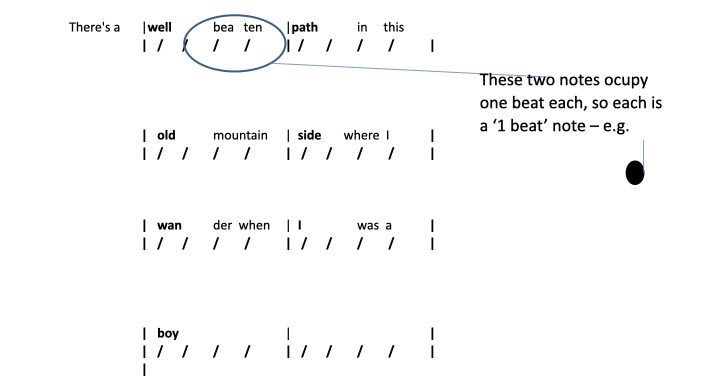

Pitch
So that’s the rhythm notated – but what about the pitch? We use the same symbols, but in conjunction with a stave.
A stave is a set of 5 lines, where each line or space indicates a note. The note values vary depending on whether we are writing for the ‘treble’ or ‘bass’ – referred to as ‘treble clef’ or ‘bass clef’. The ‘clef’ is a sign at the start of each line that tells us what register we are working in.
- Treble Clef – everything above middle C
- Bass Clef – everything below middle C
As with working out and understanding scales, the piano keyboard makes it much easier to understand the different clefs, and the concept of the stave. Lets start with the terms Treble and Bass :
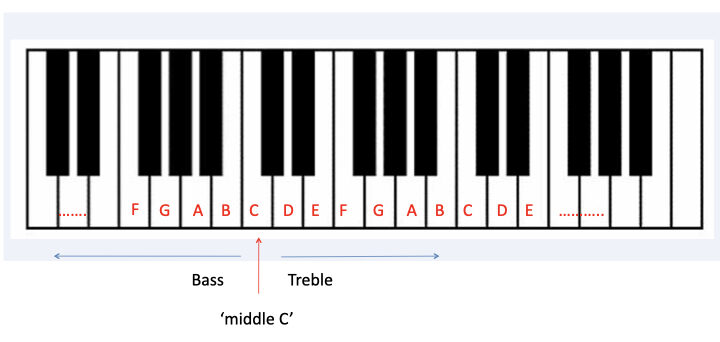
Notes are displayed on a set of 5 lines known as a stave. Each line corresponds to a different pitch (i.e. a note on the keyboard). The note represented varies depending on whether we are representing Treble or Bass clefs. Each space or line on the stave matches a ‘white key’ on the keyboard. The Treble Clef notes are mapped like this :


Blueridge Cabin Home
Lets look at what Blueridge Cabin Home looks like when the tune is notated.
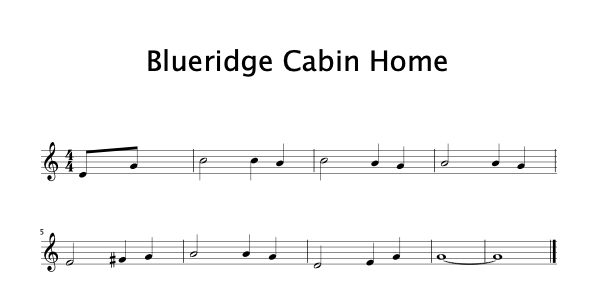
There are a few things to note here.
First of all the tails (the lines attached to the circle that forms each note). These either point up or down. The convention is that all the notes which are B or lower (the third line or below) point down while the others point up. This is simply to keep it looking neat, and is the standard way of organising the tails, so all printed music looks the same.
Before the notes appear, there are two figure 4s. on top of each other. This is the time signature and indicates the number of beats per bar (the top number) and the type of beat (the bottom figure). 4 over 4 indicates that there are 4 beats to the bar, and each one is a quarter note (or crotchet). This is the most common time signature in bluegrass, with the next being 3 over 4, which indicates a waltz (sometimes referred to as ‘three time‘).
Note that the first two notes (the upbeat, or lead in) are eight notes, or quavers. This is indicated by the single bar joining the tails together. These note are played twice as quickly as the quarter notes (or crotchets), which are the notes that have thewir centre filled in – e.g. the second and third notes in the first full measure, or bar.
The first bar or measure contains a half note, or minim, followed by two quarter notes. The half note is played twice as slow as the quarter note, and therefore lasts for a count of two beats, while the quarter note lasts for a beat each.
In the last two measures there is a note which is a empty circle without a tail. This is a whole note, or semibreve and lasts for a count of 4. Blueridge Cabin Home ends with a long G, which is held for two bars. Because of this, it is notated as two single whole notes, connected by a curved line, known as a ‘tie‘, which indicates that the two notes should be considered as one long note, lasting for 8 beats.
Nashville Numbering
What Is The Nashville Number System?
The Nashville Number system is the greatest thing ever invented for the working musician. If you will take the time to understand it, the Nashville Number System will revolutionize your playing and understanding of music.
When Neil Matthews created the original Nashville Number System in the late 1950’s, he was looking for a way to help him and the other members of the Jordanaires, Elvis Presley’s Vocal Backup Group, learn vocal parts more quickly. He took the old 7 step Shape Note System and created a tool to help him and the other Jordanaires learn their parts.
Charlie McCoy, a Nashville session musician and music leader of the Hee Haw television show, took what Matthews created and, together with some of his recording session friends came up with the system musicians use today.
For musicians, the Nashville Number System is a chord charting system that makes charting music and transposing keys easier and quicker. With this system, the scale degrees of the major scale, C-D-E-F-G-A-B-C, are changed to numbers. The major scale using the Nashville Number System would be 1-2-3-4-5-6-7-8. Session musicians in Nashville use this system to help them create the parts we hear on the records and CD’s we listen to.
Start Thinking In Numbers
With traditional printed music, the kind with lines and little black notes on sheets of paper, everything you are supposed to play is written on the paper and you play it just like it is written.
With the Nashville Number System, the number chart represents the chord progression of the song. Musicians read the chart and interpret it musically in their own way based on their experience. Most musicians using Nashville Number System play by ear so interpretations vary, sometimes greatly.
This is also how many Pop/Rock/Jazz arrangements work, but the actual chords are usually written down rather than the ‘Nashville number’
It’s all about scales
The major (and minor) scale, which is the standard scale used in Bluegrass and 99% of all popular Western music, contains 7 different notes. If you don’t know this, you need to go on the Sore Fingers Basic Music Theory course – or at least read the notes for it!
For example, the scale of G major is
G – A – B – C – D – E – F#
(plus a final G to round off the scale, and also start the next sequence.)
If we number these starting at 1 to 7, we get a numeric value for what are known as the ‘degrees’ of the scale – e .g.
- G = 1
- A = 2
- B = 3
- C = 4
- D = 5
- E = 6
- F# = 7
Blue Ridge Cabin Home
The ‘traditional’ way of identifying chords for songs is to write the chord names under the words – e.g.
There’s a well beaten path in this old mountain side | G / / / | G / / / | C / / / | C / / / | Where I wander when I was a lad | D / / / | D / / / | G / / / | G / / /To re-write this using Nashville Numbering – we replace the chord names with its number. This song uses chords G, C and D (if it is being played in the key of G), and from the chart above, we know that, in the key of G, G is chord 1, C as chord 4, and D is chord 5. Therefore we can rewrite the song as follows;
There’s a well beaten path in this old mountain side | 1 / / / | 1 / / / | 4 / / / | 4 / / / | Where I wander when I was a lad | 5 / / / | 5 / / / | 1 / / / | 5 / / /That’s the basics – but of course not all songs just use chords 1, 4 and 5! If we look at some songs that use other chords, a couple of conventions become apparent;
- The seventh chord is flattened by convention (that is the chord on the seventh note of the scale)
- Under Nashville numbering, all chords are major unless explicitly notated
Songs with a ‘7’ chord
There is a difference between a ‘7’ chord and a ‘7th’ chord !! Don’t get them mixed up. A ‘7th’ chord is a triad with the dominant 7th added – e.g. G7, which is a chord containing the notes G B D and F.
When we talk about ‘the 7 chord’ in Nashville numbering we mean a chord based on the 7th note of the scale. – and by convention this is on the ‘flattened’ 7th note – i.e. the 7th note of the scale taken down a half step. In the key of G, our scale notes are
G – A – B – C – D – E – F#
So the 7th note in the scale is F sharp. However, by convention, in Nashville numbering when we talk about the ‘7 chord’ we mean the chord that is on the flattened 7th note – i.e. the 7th note of the scale taken down one half step (or 1 fret if you prefer to think of it like that). This means that F sharp is flattened to plain F, or F natural to give it is correct name. The reason for this is quite simple – just about every bluegrass song that uses a ‘7’ chord is using the flattened 7.
Love Please Come Home
It’s easiest to take an example – let’s look at ‘Love Come Home’
As you read this letter that I write to you, | 1 / / / | 7 / / / | Sweet heart I hope you’ll understand 4 / / / | 1 / / / | That you’re the only love I knew 4 / / / | 1 / / / | Please forgive me if you can 1 / 5 / | 1 / / / |
Pick a key and play the above – what chord do you play when it says ‘7’ ? In G you should be playing an F, in C you should be playing a Bb, etc.
Minor chords
By convention all chords in Nashville numbering are major. Of course we do use minor chords in bluegrass, most notably (but not always!) when we play chords on the 3rd and 6th degrees of the scale. We signify this by simply writing an ‘m’ after the chord – so if we take a song like Rocky top we get the following – this has been notated in both chard and Nashville numbering.
Wish that I was on Old Rocky Top G / / / | C / G / | 1 / / / | 4 / 1 / | Down in the Tennesee Hills G / D / | G / / / | 1 / 5 / | 1 / / / | Aint no smoggy smoke on Rocky Top G / / / | C / G / | 1 / / / | 4 / 1 / | Aint no telephone bills G / D / | G / / / | 1 / 5 / | 1 / / / |
Once I had a girl on Rocky Top
Half bear, other half cat
Wild as a mink but sweet as soda pop
I still dream about that
Chorus Rocky Top, you’ll always be Em / / / | D / / / | 6m / / / | 1 / / / | Home sweet home to me F / / / | C / / / | 7 / / / | 4 / / / | Good Ol Rocky Top C / / / | G / / / | 4 / / / | 1 / / / | Rocky Top Tennessee G / D / | G / / / | 1 / / / | 4 / / / |
Why Use it ?
Once you get used to thinking in numbers rather than chords, it makes learning songs very quick – and there are 2 major advantages;
- Transposition
- Communication
Transposition worries become a thing of the past – either capo or play in different position depending on your instrument. If you are a capoing instrument, starting thinking of your G chord as ‘1’ and your C and D chords as 4 and 5 respectively. If you are non-capoing instrument, try to think of the chords as numbers when you are in a key rather than absolute chord names.
Song structures can be communicated very simply and quickly;
Its 1 4 5, with a 2 in the chorus
Thats much easier to remember than the chords, especially if you have a mixed band with some capoing or not. Look at the start of Rocky Top, and imagine trying to communicate that in a jam, playing in A. Guitars and banjos will almost certainly be capoing on the second fret, so if we look at the frist two lines of the chorus;
Non capoing instruments will play
F#minor – E – G – D
Instruments capoing on the second fret will play
Eminor shape – D shape – F shape – C shape
So if you just shout “F#minor!, E!, G!, D! ” …
The capoing instruments might well play those shapes, but actually be playing G# minor, F#, A and E !
It can all get very confusing – but a simple 6, 5, 7, 4 applies to everyone, and is easier to remember, especially if you try to try it again in a different key.
Finally, chords can be communicated with fingers – which is very quick and clear in a noisy jam environment!